Aikido AttacksGyaku hanmi relation Kogeki, the Attack Techniques in Aikido.Gyakuhanmi RelationThe gyakuhanmi relation is when the two opponents have differing arms and legs forward, such as the left on one and the right on the other. This can happen when a left-handed person meets a right-handed one, which is particularly awkward for right-handed persons, since they are in a vast majority. In a gripping attack, though, it is the most common relation.
Gyakuhanmi relation
 Gyakuhanmi katatedoriGyakuhanmi katatedori is when uke grabs tori's nearest grip, so that the right hand grabs the left wrist, or the left hand grabs the right wrist. In the basic form, their foot positions are the same — when uke grabs with the right hand, his or her right foot is forward, and so is tori's left foot — as opposed to what is the case in aihanmi katatedori.This grip is the most common in aikido — so much so that it is usually just called katatedori (gyakuhanmi taken for granted). Indeed, it is the most convenient way to grab an opponent's wrist, but the gyakuhanmi relation between the two is not that common in normal Martial arts guards, where the aihanmi relation is almost always the case. Therefore, I am not sure that gyakuhanmi should be allowed such a dominant role in training — they are both needed. Anyway, regarding the grip itself, it should be done in very much the same way as aihanmi katatedori — the little finger being the most important one, the angle and position of the hand, the tight contact with the palm on tori's wrist, and so on. See the text on aihanmi katatedori, above.
 The difference from aihanmi katatedori is that gyakuhanmi is by necessity off center. Both for uke and tori, the grip is to the side of the body, not straight in front of it. Still, it is necessary to feel the connection with the center, and not to regard the grip as something applied from the shoulder down. Also, uke should apply the grip as an initial and not a final attack, that means alertness and a continued focus on tori. An important key to understanding the gyakuhanmi relation as well as its katatedori application, lies in carefully considering the potential of the free hand — of both uke and tori. If this is neglected, the attack is of little value.
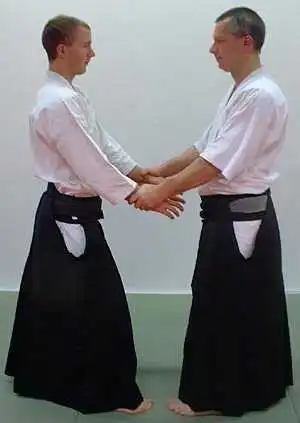 RyotedoriRyotedori is when uke grabs both of tori's wrists. It can simply be described as a double gyakuhanmi, and what goes for the latter applies also here. Since ryotedori is connected to gyakuhanmi, in the basic form the stance of uke and tori should relate in the same way — that is, if one has left foot forward, the other should have right foot forward, and vice versa.An interesting aspect of ryotedori, and other two-hand grips on both sides of tori, is the deviation from a single line connection with the center. Here, both uke and tori are so to say split, in regard to their center. Uke must still feel his grips as extensions of power from the center, and still regard the grips as a means to contact with and control over tori's center. Because of this "split from the center", I would say that ryotedori relates more to jo (the staff) than to ken (the sword). With the staff, the hands are usually separated, and should be able to move freely up and down the full length of the staff — one should still be able to maintain one's center, and to fetch the source of each movement from there. For the training of awareness of both uke and tori, it is also good to carefully consider the potential of the legs in this position. The arms are locked in the grips, but the legs are not.
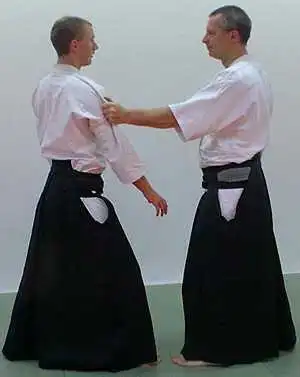 KatadoriKatadori is a grip in tori's keikogi (training jacket) by the shoulder. Uke should have the same foot forward as the hand gripping tori. The stance is a gyakuhanmi relation, which means that if uke stands with left foot forward, then tori has right foot forward, and vice versa.When you grab tori's dress, make sure that it is done mostly with your little finger, which anchors the grip in your center and makes you more flexible than if done with your power in the index finger. Don't let your thumb get too nestled into the cloth of tori's jacket. Actually, you should be careful about all your fingers, since some aikido techniques really tie them into tori's jacket in a way that might harm them during the technique.
The attack form katadori, from a seminar in the Czech Republic.
Of course, the grip should be done in the spirit of being an initial attack, with a readiness to continue with other attack forms (like in katadori menuchi, below).
 RyokatadoriRyokatadori is when uke grips tori's jacket by both the shoulders, simply a double katadori. The stance is a gyakuhanmi relation, which means that if uke stands with left foot forward, then tori has right foot forward, and vice versa.Do the grabbing in the same way as described above about katadori — with the little finger, careful not to get your fingers too much nestled into the cloth of tori's jacket, and by the sides of the shoulders instead of on top of them. In this position you really need to be able to control tori's arms to some extent, since both of your own arms are locked in the grip you applied. The grip should be done in the spirit of being an initial attack, with a readiness to continue with other attack forms (with the legs, or by pulling or pushing tori). Actually, it is not a very practical attack at all, if not some continued attack is intended. Notice that this attack needs you to face tori straight on, to have a good control, so avoid any hanmi kamae turn of your body (hanmi kamae is when you stand with one side of your body slightly more forward than the other). Notice also that this is an attack form which is a bit awkward to apply if tori stands in an accentuated hanmi kamae. Therefore, it makes the most sense if tori, too, stands straight forward.
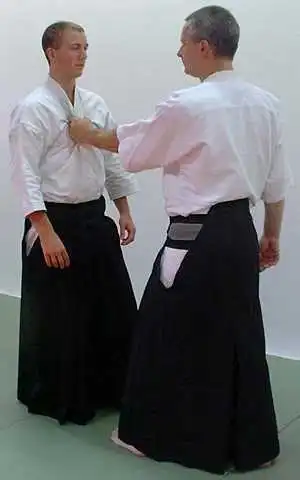 MunedoriMunedori (sometimes spelled munadori) is when uke grips tori's jacket by the front, right on the chest. Because of its similarity with katadori, the stance is a gyakuhanmi relation, which means that if uke stands with left foot forward, then tori has right foot forward, and vice versa. Of course, uke should stand with the same foot forward as the hand doing the grip.Do the grabbing in the same way as described above about katadori — with the little finger, careful not to get your fingers too much nestled into the cloth of tori's jacket. Your hand should be positioned so that your little finger is down and your thumb up, which keeps a good link to your center and your elbow down. When your elbow is down, tori will have the most difficulty in applying a technique on your arm. Also, try to apply the grip directly with just one hand — don't start by adjusting the collar of tori's jacket with the other hand. If you do, then tori should really act on the first hand coming, not wait for the next one. The grip should be done in the spirit of being an initial attack, with a readiness to continue with other attack forms. What makes this attack particularly interesting for tori is its firmness — correctly applied, this grip is not easy to get out of. An additional difficulty is the fact that tori doesn't have too much room for applying an aikido technique, since uke is so close and blocking much of the space in front of tori. This is an attack form which is a bit awkward to apply if tori stands in an accentuated hanmi kamae. Therefore, it makes the most sense if tori stands straight forward.
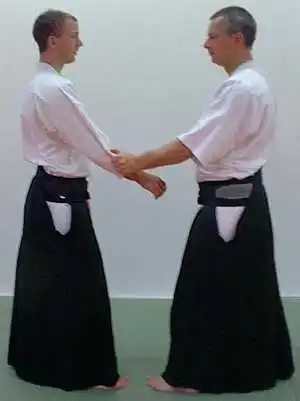 SodedoriSodedori is when uke grips tori's jacket by the end of the sleeve. It is closely related to gyakuhanmi katadori, so in the stance, if uke stands with left foot forward, then tori has right foot forward, and vice versa. Of course, uke should stand with the same foot forward as the hand doing the grip.Do the grip mainly with the little finger, and with the same angle of the hand as in katatedori. The grip should be done in the spirit of being an initial attack, with a readiness to continue with other attack forms. It is not a very interesting attack form, except for its lack of physical contact body to body, which makes it a little more difficult for tori to gain control of uke, than in katatedori. Usually, this grip is mostly trained in the double form, ryosodedori. Still, it's not one of the major attack forms in aikido.
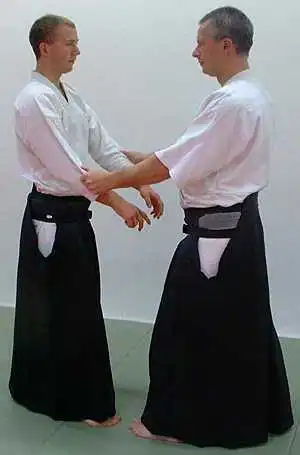 RyosodedoriRyosodedori is when uke grips tori's jacket by the end of both the sleeves. It is closely related to ryotedori (and to sodedori, of course), so in the stance, if uke stands with left foot forward, then tori has right foot forward, and vice versa.Do the grips mainly with the little finger, and with the same angle of the hand as in katatedori. Stand straight toward tori, not in a hanmi kamae angle, for better control. Also, if tori stands in too much of a hanmi kamae angle, this grip is awkward to apply for uke. Therefore, it's best if both stand straight toward each other. The grips should be done in the spirit of being an initial attack, with a readiness to continue with other attack forms (with legs, pushing or pulling). It is not a very interesting attack form, except for its lack of physical contact body to body, which makes it a little more difficult for tori to gain control of uke, than in for example ryotedori. Usually, this grip is mostly trained in the double form, ryosodedori, and not in the single version sodedori. Still, it's not one of the major attack forms in aikido.
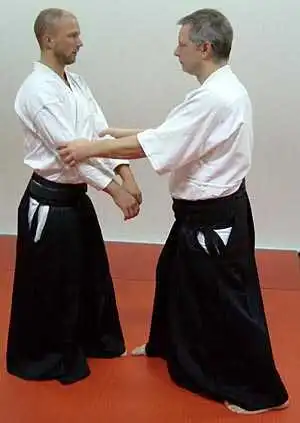 RyohijidoriRyohijidori is when uke grips both of tori's elbows. It is closely related to ryotedori and to ryosodedori. The stance is the same: if uke stands with left foot forward, then tori has right foot forward, and vice versa.Grab around the elbows. Stand straight toward tori, not in a hanmi kamae angle, for better control. Also, if tori stands in too much of a hanmi kamae angle, this grip is awkward to apply for uke. Therefore, it's best if both stand straight toward each other. The grips should be done in the spirit of blocking tori from attacking. It's not easy to control somebody's elbows, which are strong even on persons who are not very muscular. This grip is mostly trained in the double form, ryohijidori, and not in the single version hijidori. It is not one of the major attack forms in aikido.
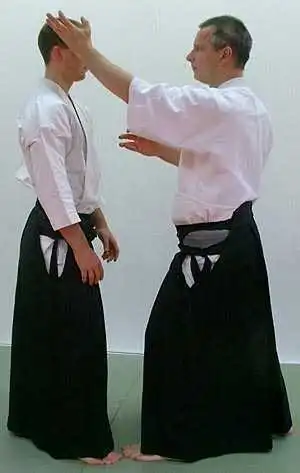 YokomenuchiYokomenuchi is when uke strikes at tori's temple with the ridge of the hand. The attack is related to shomenuchi, but here the stance has a gyakuhanmi relation, that is if uke has left foot forward, then tori has right foot forward, and vice versa. Uke should have the same foot forward as the hand that strikes.Like shomenuchi, this is really a sword attack, but done with an unarmed hand. The hand in this form is called tegatana (hand sword). The angle of the strike is not horizontal, but diagonal — in kendo the difference between shomen and yokomen is not much at all.
Don't allow yourself too much of a hanmi angle to your stand, although it's tempting as the attack is a bit from the side, but you lose a lot of power and sharpness in the strike if you do not face tori straight on. There is an unarmed attack similar to yokomen, in karatedo. It is done with shuto, the hand ridge, in a circular horizontal strike. Usually, this technique is not the one intended in aikido, but the sword cut. Of course, it is possible to train both. When you do the karatedo shuto technique, allow your elbow to extend to your side, so that you can swing the forearm forcefully in the horizontal strike — but when you do the sword form, it is not correct to open yourself up with your arm out to the side. Unfortunately, the latter is done by so many aikidoka, that they allow tori's defense technique to adapt to it — and be practically impossible if a correct sword style yokomen is done.
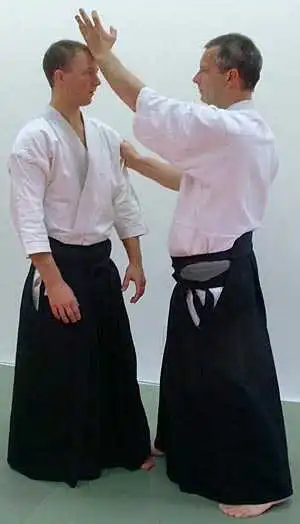 Katadori menuchiKatadori menuchi is a combination of two attacks: katadori and shomenuchi. Uke grabs tori by the shoulder, and immediately follows up with a shomenuchi strike. Since the initial attack is katadori, the relation between uke and tori is that of gyakuhanmi, so that if one has the left foot forward, then the other has right foot forward. For how to apply the katadori grip and the shomenuchi strike, see the texts about those, above.In most aikido dojos, the students are taught that tori should wait for the second attack, the shomenuchi. I am not really fond of that, since a basic principle of aikido should be to act on what comes first. It is far better for tori to treat the attack as a katadori, and a correct initial taisabaki should result in the shomenuchi missing its target, anyway. But that is of little concern to uke, of course. Uke should just make sure to do the attack so, that there is no pause between the katadori grip and the shomenuchi strike.
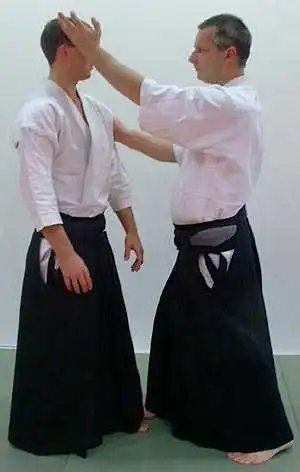 Katadori yokomenuchiKatadori yokomenuchi is a combination of two attacks: katadori and yokomenuchi, very similar to katadori menuchi above. Uke grabs tori by the shoulder, and immediately follows up with a yokomenuchi strike. Since the initial attack is katadori, the relation between uke and tori is that of gyakuhanmi, so that if one has the left foot forward, then the other has right foot forward. For how to apply the katadori grip and the yokomenuchi strike, see the texts about those, above.This is not a very common attack form in aikido — usually the katadori menuchi is used, with a shomen strike, and rarely a yokomen strike. The yokomen is a bit more awkward to do, since it is to the other side of tori, from where the katadori grip is applied. In the sword arts, though, there is actually little difference between shomen and yokomen, so where one is easy to to do, the other should be almost as easy. Just like with katadori menuchi, most aikido students are taught that tori should wait for the second attack, the shomenuchi. I prefer to act directly on the first attack, the katadori. Anyway, uke should make sure to do the attack so, that there is no pause between the katadori grip and the yokomenuchi strike. Of course, it is also possible to combine katadori with other follow-up attacks, for example jodan tsuki, a fist punch to the head. That is not a basic attack form in aikido, but worth trying anyway.
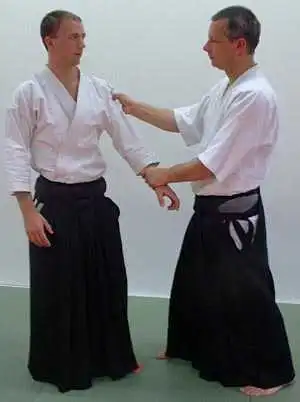 Kata katatedoriKata katatedori is a combination of two attacks: katadori and katatedori. Uke grabs tori by the wrist and the shoulder, either simultaneously or in very quick succession. Usually this is done with the same foot forward as the hand that applies the katadori grip, since it is otherwise difficult to reach the shoulder. Because of this, the relation between uke and tori is gyakuhanmi — that is, if one has left foot forward, the other has right foot forward.For how to apply the katadori and the katatedori grip, see the texts about those, above. Notice that the katatedori grip is like aihanmi, but the stance is like gyakuhanmi. This is a rare attack form in aikido — I have not even found it in a Google search (maybe another name is used for it, than kata katatedori). It is not very practical if uke is alone in doing it, since both arms will be locked, while tori has one arm free. In futari (two attackers), though, it is a practical holding technique, if done on both arms of tori.
AIKIDO PRACTICEIntroductionAikido Techniques — all the basic movesAttacks in Aikido
Tantodori — knife defenseAikiken — aikido sword techniquesJo 31 Kata in four directionsAikibatto sword and staff exercisesAiki — joining energiesKi exercisesAikido Video ClipsAikido PhotosMy aikido dojo in Malmö, SwedenMy aikido seminarsAIKIDO THEORYMy Aikido BioAikido GlossaryTanden, the CenterAikido InksAikido as Self-DefenseRunning a DojoAikido is TrueOsensei and EinsteinAikiWeb ColumnsAikido Books ReviewedDie deutsche Version meines Aikido-Buches onlineAikido på svenskaAbout CookiesMy Other WebsitesCREATION MYTHSMyths in general and myths of creation in particular.
TAOISMThe wisdom of Taoism and the Tao Te Ching, its ancient source.
LIFE ENERGYAn encyclopedia of life energy concepts around the world.
QI ENERGY EXERCISESQi (also spelled chi or ki) explained, with exercises to increase it.
I CHINGThe ancient Chinese system of divination and free online reading.
TAROTTarot card meanings in divination and a free online spread.
ASTROLOGYThe complete horoscope chart and how to read it.
MY AMAZON PAGE
MY YOUTUBE AIKIDO
MY YOUTUBE ART
MY FACEBOOK
MY INSTAGRAM
MY TWITTER
STENUDD PÅ SVENSKA
|
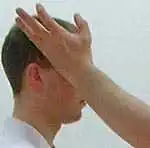 Form and use your hand the same way as in shomenuchi, keeping it hardened especially at the hand ridge. Make sure to swing your whole arm in the strike, not just the forearm. Let your other hand follow a bit behind, to resemble the two-hand sword grip.
Form and use your hand the same way as in shomenuchi, keeping it hardened especially at the hand ridge. Make sure to swing your whole arm in the strike, not just the forearm. Let your other hand follow a bit behind, to resemble the two-hand sword grip. Aikido Principles
Aikido Principles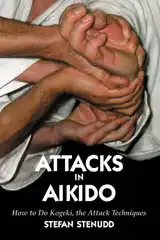 Attacks in Aikido
Attacks in Aikido Aikibatto
Aikibatto
